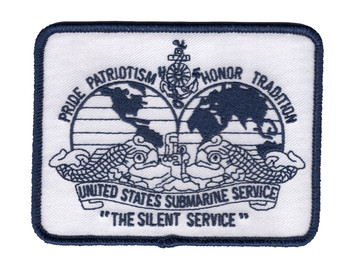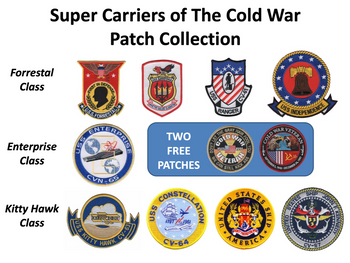Description
Cold War Silent Service Patch (U.S. Navy) 4.0" x 5.0" Embroidered Patch with Iron-On Backing
Superior Materials: Made with premium polyester thread and durable twill fabric, ensuring long-lasting color and strength.
Advanced Embroidery Technology: Crafted using the most advanced embroidery machinery, guaranteeing intricate detail, sharp lines, and consistent quality every time.
Easy Iron-On Application: Features a heat-activated adhesive backing for quick, no-sew attachment. Simply position, iron, and press for a secure bond.
Versatile Use: Perfect for personalizing jackets, backpacks, uniforms, or any fabric surface that needs a touch of personality.
Durable and Washable: Designed to withstand everyday wear and occasional washing without fading or fraying.
Formations & Origins
The Cold War Silent Service Patch is a symbol of the U.S. Navy’s submarine force during the tense and secretive years of the Cold War. The patch represents the Navy’s submersible fleet, which operated largely beneath the surface to maintain deterrence against Soviet aggression. The U.S. Navy's Silent Service became a critical force in the Cold War, as submarines, particularly nuclear-powered submarines, were considered a cornerstone of U.S. strategic military capability.
The origins of this "Silent Service" date back to the early 20th century, but its prominence during the Cold War was undeniable. Submarines during this era were tasked with remaining undetected while patrolling the world's oceans, ready to launch nuclear retaliatory strikes if necessary. The term "Silent Service" refers to the secrecy and stealth that submarines provided, making them a formidable yet hidden element of the U.S. military during a time when the threat of nuclear warfare loomed large. The Cold War Silent Service Patch was worn by submariners to honor their role in this clandestine yet vital mission, serving as a reminder of the crucial operations they carried out during the Cold War.
Notable Commanders
The role of submarine commanders during the Cold War was vital in maintaining the security of the United States and its allies. One of the most notable figures of this era was Admiral Hyman G. Rickover, often referred to as the “Father of the Nuclear Navy.” Admiral Rickover played a crucial role in developing the U.S. Navy's nuclear-powered submarines, including the USS Nautilus, the world’s first nuclear-powered submarine. His leadership and vision for the future of submarine warfare shaped the modern Silent Service and the strategic importance of submarines in Cold War deterrence.
Another significant figure was Vice Admiral James B. Stockdale, a decorated Navy aviator and later a highly influential leader in the submarine community. His leadership during the Cold War, especially in the areas of strategic planning and operational excellence, helped to strengthen the Navy’s submersible force.
Major Campaigns/Operations
During the Cold War, the U.S. Navy’s submarines played a key role in the U.S. strategy of nuclear deterrence against the Soviet Union. Submarines patrolled the world’s oceans, ensuring that the U.S. could maintain a second-strike capability if nuclear war ever occurred. The Submarine Ballistic Missile Nuclear (SSBN) force was integral to maintaining the balance of power during this time, providing the U.S. with a powerful, mobile, and stealthy retaliatory force.
The USS George Washington (SSBN-598) was the first nuclear-powered ballistic missile submarine, commissioned in 1959, and marked a turning point in submarine warfare. Its success and the subsequent fleet of SSBNs ensured that the Navy's Silent Service became a critical part of America’s strategy to prevent Soviet aggression. The Silent Service’s stealthy, covert patrols helped to ensure that the U.S. maintained a credible and powerful deterrence, ensuring that the threat of nuclear retaliation was always present, even in the event of a surprise attack.
In addition to their deterrent mission, submarines were involved in intelligence gathering and special operations during the Cold War. The U.S. Navy’s submarine fleet conducted reconnaissance missions along the coastlines of the Soviet Union, monitoring their movements and gathering vital intelligence, all while remaining undetected. These missions often took place in hostile waters, making them among the most dangerous and crucial operations of the era.
Specialized Role/Equipment
The Cold War Silent Service was defined by its reliance on stealth, specialized equipment, and the ability to carry out complex missions under extreme secrecy. Submarines of this era were equipped with nuclear reactors, allowing them to stay submerged for extended periods, often for months at a time, without the need for refueling. This ability to remain undetected and operational for prolonged periods was critical to their role in Cold War deterrence.
The submarines of the Silent Service were outfitted with the most advanced weapons of the time, primarily ballistic missiles capable of carrying nuclear warheads. These missiles were designed to be launched from beneath the ocean’s surface, making them an incredibly difficult target for enemy detection. In addition to the SSBNs, the attack submarines (SSNs) also played a vital role, tasked with missions ranging from intelligence gathering to providing support to larger fleets. The Los Angeles-class and Seawolf-class submarines were among the most sophisticated attack submarines built during the Cold War.
Acts of Heroism
Though much of the work of the Silent Service was shrouded in secrecy, acts of heroism were still evident throughout the Cold War. One of the most notable moments of heroism was during the Cuban Missile Crisis in 1962, when U.S. submarines played a pivotal role in ensuring that a confrontation with the Soviet Union did not escalate into full-scale nuclear war. During the crisis, submariners aboard the USS Tullibee (SSN-597) and other submarines carried out critical reconnaissance missions, remaining submerged and undetected while monitoring Soviet vessels.
In a more dramatic example, during Operation Ivy Bells in the 1970s, U.S. Navy submarines engaged in covert intelligence operations to intercept Soviet underwater communications. Submariners involved in this operation demonstrated remarkable courage and resourcefulness as they infiltrated Soviet naval bases to tap into undersea communication cables, all while navigating Soviet waters undetected and maintaining the highest level of secrecy.
The USS Scorpion (SSN-589) disaster in 1968, though tragic, also highlighted the bravery and commitment of the men serving in the Silent Service. The loss of the Scorpion, which sank under mysterious circumstances, led to a comprehensive investigation that improved submarine safety standards for the future. The crew's courage under uncertain conditions remains a somber reminder of the risks that submariners took during the Cold War.
Legacy & Notable Achievements
The legacy of the Cold War Silent Service Patch is one of quiet yet profound contribution to U.S. national security. The submarine force of the Cold War ensured that the U.S. maintained a credible nuclear deterrent at a time when the threat of total war with the Soviet Union was a real possibility. The achievements of the Silent Service include not only successful deterrence and intelligence gathering but also advances in submarine technology that shaped the Navy’s future.
The development of nuclear-powered submarines, particularly the SSBNs, revolutionized naval warfare, providing the U.S. with the ability to launch nuclear strikes from virtually anywhere in the world, while remaining hidden beneath the waves. This capacity for strategic ambiguity was a powerful tool in the Cold War, ensuring that the balance of power was tipped in favor of the U.S. Navy.
The Silent Service’s legacy is also one of innovation. The U.S. Navy’s submarine force pioneered the use of advanced sonar systems, missile technologies, and nuclear propulsion, all of which continue to shape submarine design to this day. The secrecy and courage demonstrated by submariners during this period helped to maintain peace during one of the most dangerous periods in modern history.
Ultimately, the Cold War Silent Service Patch represents a chapter in the history of the U.S. Navy where bravery, technological advancement, and stealthy operations were critical in maintaining peace during the Cold War. The sailors who served in this elite and often unsung branch of the military were vital in ensuring that the world never saw the outbreak of a nuclear conflict.

















